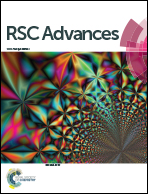In vivo toxicity evaluation of two polyoxotungstates with potential antidiabetic activity using Wistar rats as a model system
Abstract
In this study, the in vivo hypoglycemic effect of a donut-shaped polyanion salt (NH4)14[Na@P5W30O110]·31H2O {NaP5W30} and its Ag-containing derivative K14[Ag@P5W30O110]·22H2O·6KCl {AgP5W30}, as well as their hepatotoxicity and nephrotoxicity, was evaluated. In the screening hypoglycemic study, Wistar albino rats with streptozotocin induced diabetes were treated intraperitoneally with three single doses (5, 10, and 20 mg per kg per b.w.) of both investigated polyoxotungstates. The blood glucose levels, measured before and after 2, 4 and 6 h polyoxotungstate application, showed that both studied compounds induced the most pronounced and time dependent glucose lowering effects at the doses of 20 mg kg−1. Thus, daily doses of 20 mg kg−1 were administered to Wistar albino rats orally for 14 days in further toxicity examinations. The serum glucose concentration and biochemical parameters of kidney and liver function, as well as a histopathological analysis of kidney and liver tissues were evaluated 14 days after the polyoxotungstate administration. Both investigated compounds did not induce statistically significant alterations of the serum glucose and uric acid concentrations, as well as some of the liver function markers (serum alanine and aspartate aminotransferases, and alkaline phosphatase activities). However, the significant decrease in serum total protein and albumin concentrations and the increase in biochemical parameters of renal function – serum urea (up to 63.1%) and creatinine concentrations (up to 23.3%) were observed for both polyoxotungstates. In addition, the detected biochemical changes were in accordance with kidney and liver histhopathological analysis. Accordingly, the hepatotoxic and nephrotoxic effects of these potential antidiabetic polyoxotungstates could be considered as mild.



 Please wait while we load your content...
Please wait while we load your content...